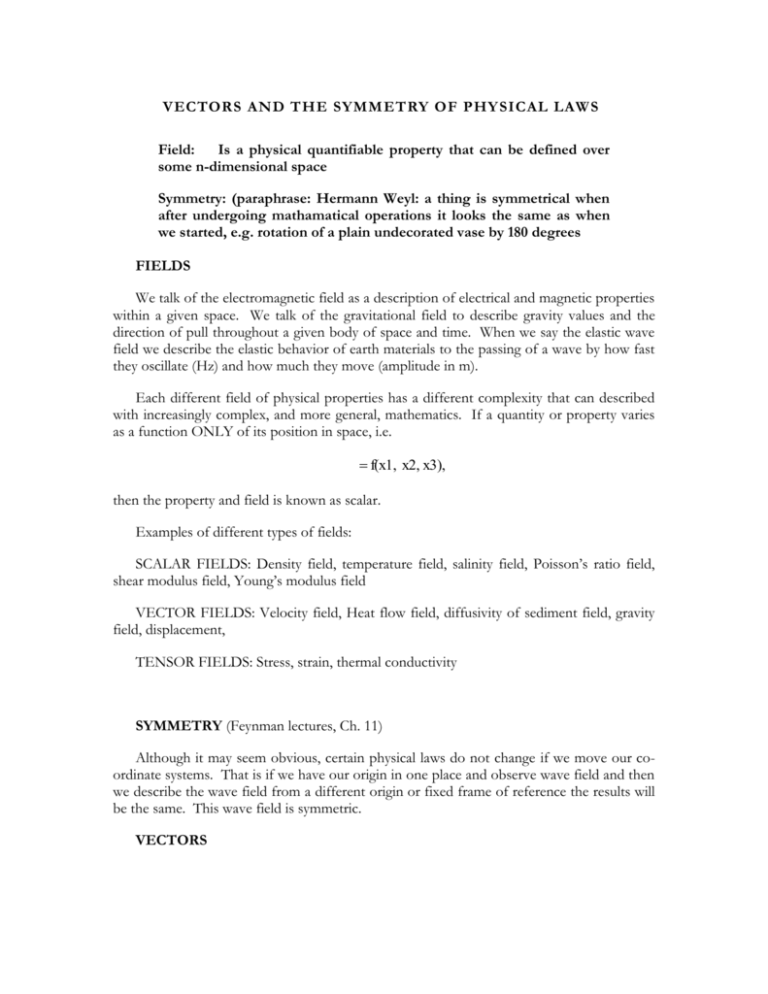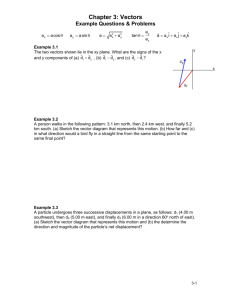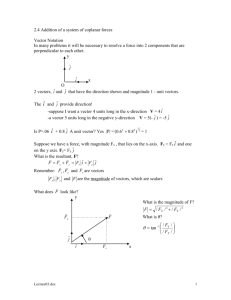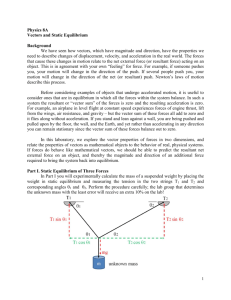Vectors
advertisement

VECTORS AND THE SYMM ETRY OF PHY SICAL LAW S Field: Is a physical quantifiable property that can be defined over some n-dimensional space Symmetry: (paraphrase: Hermann Weyl: a thing is symmetrical when after undergoing mathamatical operations it looks the same as when we started, e.g. rotation of a plain undecorated vase by 180 degrees FIELDS We talk of the electromagnetic field as a description of electrical and magnetic properties within a given space. We talk of the gravitational field to describe gravity values and the direction of pull throughout a given body of space and time. When we say the elastic wave field we describe the elastic behavior of earth materials to the passing of a wave by how fast they oscillate (Hz) and how much they move (amplitude in m). Each different field of physical properties has a different complexity that can described with increasingly complex, and more general, mathematics. If a quantity or property varies as a function ONLY of its position in space, i.e. f(x1, x2, x3), then the property and field is known as scalar. Examples of different types of fields: SCALAR FIELDS: Density field, temperature field, salinity field, Poisson’s ratio field, shear modulus field, Young’s modulus field VECTOR FIELDS: Velocity field, Heat flow field, diffusivity of sediment field, gravity field, displacement, TENSOR FIELDS: Stress, strain, thermal conductivity SYMMETRY (Feynman lectures, Ch. 11) Although it may seem obvious, certain physical laws do not change if we move our coordinate systems. That is if we have our origin in one place and observe wave field and then we describe the wave field from a different origin or fixed frame of reference the results will be the same. This wave field is symmetric. VECTORS Vector is a quantity that has a direction as well as a value in space. With a vector we know HOW MUCH it is worth and whether this quantity acts in a certain direction. A vector is described using three numbers. Figure 1: Threedimensional basis vectors are mutually orthogonal and are indexed following the right-hand rule Basis or unitary vectors in a cartesian co-ordinate system are mutually orthogonal to each other, are of unit length and obey the right-hand rule. We can describe these vectors in several ways: V a1 xˆ1 a2 xˆ 2 a3 xˆ3 or V ai xˆi ( If indices are repeated by convention we sum over them) Invariance of Vectors under Linear Transformation A vector property is also a property that is symmetric. That is that it does not matter whether these three numbers are different because they are determined measured with respect to different origins or frames of reference. They will still describe the same physical behavior, of say, the wave field. For example, if a vector is describing the velocity of the wave field of the earth’s surface in a direction that is not perpendicular to the earth’s surface we may choose to more conveniently rotate the co-ordinate reference frame in line with the particle motion. a'1 cos a' sin 2 V' TV , sin a1 or, more briefly expressed as cos a2 where V is the vector after the transformation expressed in components in terms of the rotated co-ordinate basis vectors and V is the vector before the transformation expressed in terms of compnents of the unaffected basis vector system. Before the rotation the co-ordinates for V are: a1 V cos , and a 2 V sin After the rotation the co-ordinates for V are: a1 V cos , and a 2 V sin . Expanding these two trigonometric functions we arrive at: a1 cos cos sin sin V , a1 cos a 2 sin and a 2 sin cos cos sin V a 2 cos a1 sin a' cos When the 1 a'2 sin sin a1 V cos a2 V









